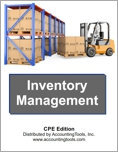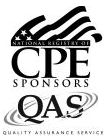Inventory Management (CPE Course)
CPE Credit: 15 hours
Course Type: Downloaded PDF materials with online test
Price (with PDF Textbook): $100
Course Description
Inventory is expensive and difficult to manage, and yet is an essential requirement for providing great service to customers. Inventory Management provides the tools to retain enough inventory to assure high levels of customer service, while avoiding excessive inventory levels that can create losses. Topics covered include inventory policies, materials planning, purchasing and the supply chain, receiving, storage, shipping, production activities, record accuracy, warehousing efficiencies, measurements, and much more. This course covers a mix of classic and advanced management techniques to keep firm control over the mix and amount of inventory.
Author: Steven Bragg
Course Number: PR1001
Table of Contents
Chapter 1. The Nature of Inventory
Chapter 2. Inventory Strategy
Chapter 3. Inventory Policies
Chapter 4. Materials Planning and Forecasting
Chapter 5. Purchasing Activities
Chapter 6. Inventory Receiving
Chapter 7. Putaways and Picking
Chapter 8. Impact of Production on Inventory
Chapter 9. Inventory Shipping
Chapter 10. Obsolete Inventory
Chapter 11. Product Development
Chapter 12. Inventory Record Accuracy
Chapter 13. Inventory Counting and Reconciliation
Chapter 14. The Supply Chain
Chapter 15. Warehousing Efficiencies
Chapter 16. Warehouse Storage Systems
Chapter 17. The Warehouse Layout
Chapter 18. Inventory Measurements
Learning Objectives
Identify the types of inventory, and the need for reorder points, safety stock, and economic order quantities.
State the manner in which inventory can be incorporated into a company’s competitive strategy, and the situations in which certain strategies should be employed.
Identify the policies that should be used to control inventory, and the situations in which they should be used.
State the types of forecasting variations that can be used, how forecasts can be incorrect, and what can be done to mitigate these effects.
State the various costs related to suppliers, how a spend management system can be created, and the issues related to volume purchase discounts.
Identify the receiving techniques that can be used to minimize inventory damage, organize incoming deliveries, create cross docking transactions, and similar issues.
State the types of equipment used in putaway and picking transactions, as well as their advantages and disadvantages.
Identify the components of the major production management systems, as well as the techniques used to improve the flow of inventory through the production process.
State the methods used to enhance the efficiency and effectiveness of the shipping function.
State who identifies obsolete inventory and how such inventory is located.
Identify the methods used in the engineering area to minimize the number of parts, improve the production process, and generally reduce the investment in inventory.
Recognize the issues that can reduce inventory record accuracy.
State the situations in which the periodic and perpetual inventory systems should be used, and issues related to physical inventory and cycle counts.
State the impact on inventory and costs of how the supply chain is managed.
Identify the methods used to increase the efficiency of the warehouse.
State the storage characteristics of inventory, as well as the situations in which various types of storage systems can be used.
Identify the steps used to plan the warehouse layout, as well as the impacts of various issues on the final layout and sizing.
Recognize the key inventory measurements and the circumstances under which they are used.
Level: Overview
Instructional Method: QAS Self-Study
NASBA Category: Production
Prerequisites: None
Advance Preparation: None
Latest Review Date: March 2024
Program Registration Requirements: Click on "Purchase Course" near the top of this page to pay for and access the course. You will then be able to download the course as a PDF file, then take an on-line examination, and then download a certificate of completion if you pass the examination.
Program Refund Policy: For more information regarding administrative policies concerning complaints, refunds, and other matters, see our policies page.
AccountingTools, Inc. is registered with the National Association of State Boards of Accountancy (NASBA) as a sponsor of continuing professional education on the National Registry of CPE Sponsors. State boards of accountancy have the final authority on the acceptance of individual courses for CPE credit. Complaints regarding registered sponsors may be submitted to the National Registry of CPE Sponsors through its website: www.nasbaregistry.org.
The NASBA sponsor identification number for Accountingtools, Inc. is 115881.
AccountingTools is an IRS Approved Continuing Education Provider. We are compliant with the requirements for continuing education providers (as described in sections 10.6 and 10.9 of the Department of Treasury’s Circular No. 230 and in other IRS guidance, forms, and instructions). Our IRS Approved Continuing Education Provider number is 72821.


